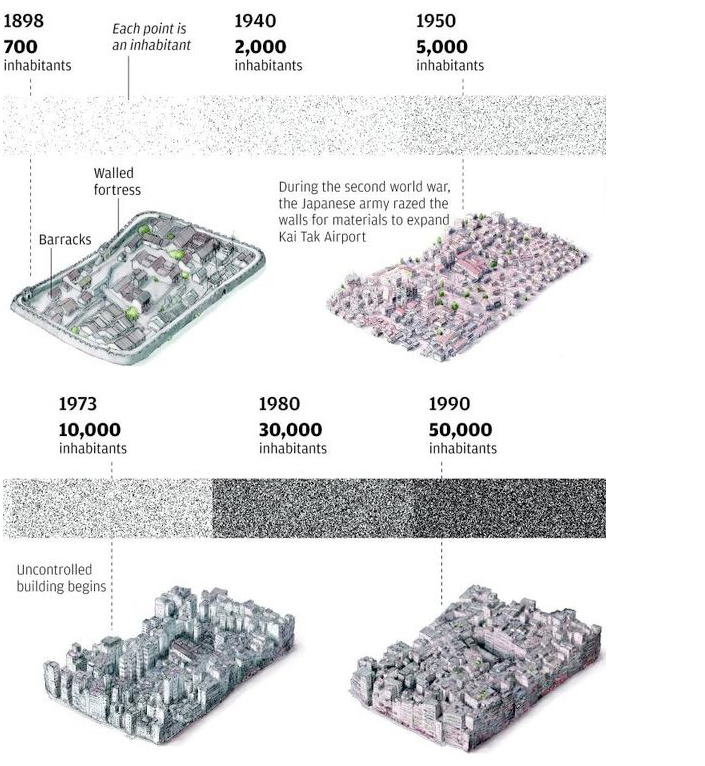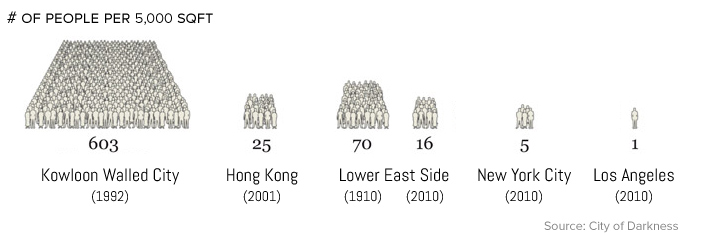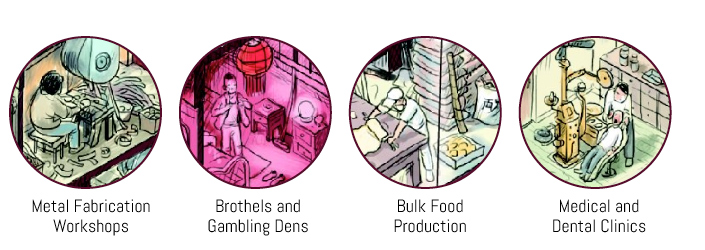Government control is an established reality for most of the world, but what would happen if a neighborhood in your city suddenly became a lawless free-for-all? What type of industries would emerge, and how would people cooperate within that environment to ensure basic services continued to operate? One example from recent history sheds light on just how such a situation could work: Kowloon Walled City.
Kowloon Walled City
Today’s infographic is a fantastic editorial illustration from South China Morning Post from 2013 that takes a detailed look at the inner workings of Kowloon Walled City (KWC). Often described as one of the most remarkable social anomalies in recent history, this bizarre enclave was more dense than any other urban area on the face of the planet.
The story of the KWC site begins in the Song Dynasty (960-1297) when a small fort was constructed to house soldiers who helped safeguard the salt trade. In the latter half of the 19th century, the small fort was expanded into a full garrison town as the threat of a British invasion hung over China. In 1898, the 99-year lease of Kowloon and the New Territories was established with one exception: the 2.7 hectare walled fortress. Because China never dropped its claim on the site and the British took a hands-off approach, the site became a sort of lawless enclave. After WWII, squatters began to fill the site and more permanent structures followed. By 1950, the population had grown to 17,000, and by 1990 over 50,000 people lived within a property the size of two rugby fields.
From Squatter Camps to Functioning Neighborhood
There was a tendency to view KWC is an isolated bubble of vice within the city, but the sheer volume of business activity within the informal settlement shows that outside customers were more than happy to benefit from lower priced goods and services. This symbiosis has few parallels in modern history, and it makes KWC a fascinating situation to look back on. KWC is best known as an enclave of criminal activity and illicit businesses such as brothels and gambling dens, but that only tells one side of the story. Despite the lack of space and formal links to utilities, the neighborhood was remarkably productive. In fact, KWC was often been described as Hong Kong’s shadow economy because the hundreds of tiny workshops and factories scattered throughout the site provided products for businesses across Hong Kong.
People moved to KWC for many reasons, including bankruptcy, poverty, or to avoid deportation. Others went there to take advantage of the lack of law enforcement and regulations. One prominent example of skirting regulation was the high concentration of dental and medical practitioners operating within KWC. In addition to lower rents, doctors who immigrated to Hong Kong from China could avoid expensive licensing and retraining required by the colonial government. Industrial businesses were free to ignore fire, labor, and safety codes to produce goods at a lower cost, or to sell items that were considered taboo in the formal economy (e.g. restaurants serving dog meat).
Law and Order
Triads acted as a de facto city council by resolving civil conflicts, creating a volunteer fire brigade, and organizing garbage disposal. The tight-knit community within the settlement would also coordinate among themselves to conserve electricity and make repairs to shared infrastructure. Despite the lack of formally recognized land ownership, people still bought and sold property within KWC. In one example, a construction company struck an exchange deal with the owner of a four-story building. The owner would retain a ground floor flat in a newly constructed thirteen-story building on the site.
The Bitter End
In 1993, after intense rounds of buy-out offers and forced relocations, Kowloon Walled City was demolished and converted into a park. Many of the businesses were forced to close forever as rents in the rest of Hong Kong were not affordable for most of the owners. – Greg Girard, author of City of Darkness on Even while political regimes across these countries have changed over time, they’ve largely followed a few different types of governance. Today, every country can ultimately be classified into just nine broad forms of government systems. This map by Truman Du uses information from Wikipedia to map the government systems that rule the world today.
Countries By Type of Government
It’s important to note that this map charts government systems according to each country’s legal framework. Many countries have constitutions stating their de jure or legally recognized system of government, but their de facto or realized form of governance may be quite different. Here is a list of the stated government system of UN member states and observers as of January 2023: Let’s take a closer look at some of these systems.
Monarchies
Brought back into the spotlight after the death of Queen Elizabeth II of England in September 2022, this form of government has a single ruler. They carry titles from king and queen to sultan or emperor, and their government systems can be further divided into three modern types: constitutional, semi-constitutional, and absolute. A constitutional monarchy sees the monarch act as head of state within the parameters of a constitution, giving them little to no real power. For example, King Charles III is the head of 15 Commonwealth nations including Canada and Australia. However, each has their own head of government. On the other hand, a semi-constitutional monarchy lets the monarch or ruling royal family retain substantial political powers, as is the case in Jordan and Morocco. However, their monarchs still rule the country according to a democratic constitution and in concert with other institutions. Finally, an absolute monarchy is most like the monarchies of old, where the ruler has full power over governance, with modern examples including Saudi Arabia and Vatican City.
Republics
Unlike monarchies, the people hold the power in a republic government system, directly electing representatives to form government. Again, there are multiple types of modern republic governments: presidential, semi-presidential, and parliamentary. The presidential republic could be considered a direct progression from monarchies. This system has a strong and independent chief executive with extensive powers when it comes to domestic affairs and foreign policy. An example of this is the United States, where the President is both the head of state and the head of government. In a semi-presidential republic, the president is the head of state and has some executive powers that are independent of the legislature. However, the prime minister (or chancellor or equivalent title) is the head of government, responsible to the legislature along with the cabinet. Russia is a classic example of this type of government. The last type of republic system is parliamentary. In this system, the president is a figurehead, while the head of government holds real power and is validated by and accountable to the parliament. This type of system can be seen in Germany, Italy, and India and is akin to constitutional monarchies. It’s also important to point out that some parliamentary republic systems operate slightly differently. For example in South Africa, the president is both the head of state and government, but is elected directly by the legislature. This leaves them (and their ministries) potentially subject to parliamentary confidence.
One-Party State
Many of the systems above involve multiple political parties vying to rule and govern their respective countries. In a one-party state, also called a single-party state or single-party system, only one political party has the right to form government. All other political parties are either outlawed or only allowed limited participation in elections. In this system, a country’s head of state and head of government can be executive or ceremonial but political power is constitutionally linked to a single political movement. China is the most well-known example of this government system, with the General Secretary of the Communist Party of China ruling as the de facto leader since 1989.
Provisional
The final form of government is a provisional government formed as an interim or transitional government. In this system, an emergency governmental body is created to manage political transitions after the collapse of a government, or when a new state is formed. Often these evolve into fully constitutionalized systems, but sometimes they hold power for longer than expected. Some examples of countries that are considered provisional include Libya, Burkina Faso, and Chad.
















